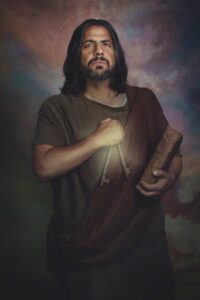"Jesus sent out these twelve. 'The kingdom of heaven is at hand.'’'
Matthew 10: 4,7
The twelve Apostles were hand-picked by Jesus to carry on His mission. The Apostles (meaning “one who is sent”) were the first bishops of the Catholic Church. They were given authority and power by Jesus, including the power to heal and to forgive sins. Peter, the chief apostle, was given special authority, including the keys to the kingdom of Heaven (see Mt. 16:19). Christ built His Church on St. Peter (see Mt. 16:18), the first pope, and promised that it would withstand the gates of Hell. The Pope today can be traced directly back to St. Peter and the other Bishops of the Catholic Church descend directly from the other Apostles. In fact, one of the four marks of the Church is its Apostolicity. Scripture tells us that in the heavenly New Jerusalem “The wall of the city had twelve courses of stones as its foundation, on which were inscribed the twelve names of the twelve apostles of the Lamb [that is, Christ].” (Rv. 21:14)
Before receiving the Holy Spirit on Pentecost, we see in Scripture that the Apostles displayed various characteristics, including doubt, fear, weakness, and imperceptiveness. One apostle, Judas, betrayed Christ and all but one abandoned Him during His agony. After receiving the Holy Spirit, however (excepting Judas who had died & did not receive the Holy Spirit), they became ‘fearless leaders’ of the Church, all but one shedding their blood for Christ.
Not included with the twelve apostles is St. Paul (formerly called Saul), who is often referred to as “the Apostle” due to his great apostolic works. As the Catechism explains, “St. Paul was an Apostle, but as he was not called till after the Ascension of Our Lord he is not numbered among the twelve. He is called the Apostle of the Gentiles; that is, of all those who were not of the Jewish religion or members of the Church of the Old Law.”
Saint Peter
Feastday: June 29 – with Saint Paul
Patron: of fishermen, net makers, and ship builders
Birth: First Century
Death: 64
Son of Jona (or Johannes, John, Jonah)
Brother of Apostle Andrew
From Bethsaida
Chief Apostle
His name was changed by Jesus from Simon to Peter (meaning “rock”)
Jesus founded His Church on Peter (see Mt. 16:18)
Jesus entrusted Peter with the keys to the kingdom of heaven (see Mt. 16:19)
Wrote two Epistles
Was crucified upside down (on same day St. Paul was martyred)
His relics are located directly beneath the high altar in St. Peter’s Basilica (Rome)
Galilean fisherman, the chief Shepherd of Christ’s flock, was chosen by Him to be the Prince of the Apostles, and the Rock upon which He was to build His indestructible Church. Symbol: crossed keys, silver and gold keys signify Saint Peter’s divinely-given power of binding and loosing.
(photo: thesaintsproject.org_KristynBrown)
Saint Andrew

Feastday: November 30
Patron: of Fishermen, singers, Scotland, Romania, Russia, Ukraine and Patras
Birth: Early 1st Century
Death: Mid-to late 1st Century
Son of Jona (or Johannes, John, Jonah)
Brother of Apostle Simon Peter
From Bethsaida
Was first Apostle called
A follower of John the Baptist, then of Christ, who led his brother, Saint Peter, to Christ. He preached the Gospel in Asia Minor and then in Greece, where he was crucified. Symbol: transverse cross, it was on this kind of cross that Saint Andrew, brother of Peter, was crucified in Greece.
(photo: The Chosen)
Saint John
Feast: 27 December
Patron of: of love, loyalty, friendships, and authors
Birth: 6 AD
Died: 100 AD
Son of Zebedee
Younger brother of Apostle James (the greater)
“Son of Thunder” (Boanerges)
Called the “beloved disciple”
Only Apostle who did not forsake Jesus during His passion
Was made guardian of Jesus’ Mother while Jesus hung on the Cross (see Jn. 19:27)
Wrote Gospel, Apocalypse/Revelation, and three Epistles
Only Apostle who was not martyred (according to tradition, he survived attempted martyrdom)
The Apostle Jesus particularly loved St. John, probably because of his great innocence and purity. It was to the care of this apostle that the crucified Christ entrusted His blessed Mother. Symbol: chalice, an allusion to Christ’s words concerning Saint John: “Of My cup you shall indeed drink.”
(photo: thesaintsproject.org_KristynBrown)
Saint Philip
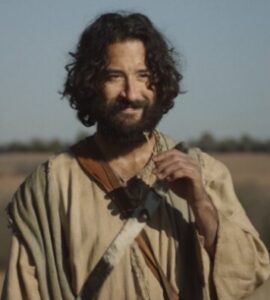
Feast: 3 May – with Saint James the Less
Patron of: pastry chefs in Catholicism because of his role in the miracle of the feeding of the multitude. He is also the patron saint of hatters and fishermen as well as some cities, churches, and schools
Birth: Early 1st Century
Died: 80 AD
Galilean, who is remembered for telling Nathanael that he had found the Messiah, and for taking him to Christ. His preaching took him to Phrygia, where he suffered martyrdom. Symbol: latin cross, Saint Philip is pictured carrying the cross of Christ, which was the theme of his preaching.
(photo: The Chosen)
Saint Bartholomew
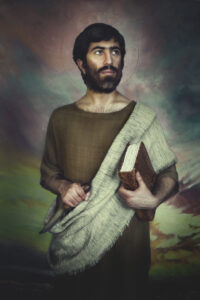
Feast: 24 August
Patron of: tanners, plasterers, tailors, leatherworkers, bookbinders, farmers, housepainters, butchers, and glove makers
Birth City: Province of ludae [Palaestina]
Birth:c. 1st Century
Died: c. 71 AD
A friend of Philip
Believed to be the Nathanael whose innocence and simplicity won high praise from the lips of Christ when Philip brought him to our Lord. He suffered and died in Armenia. Symbol: knife, the traditional symbol for Saint Bartholomew it was this instrument which was used to flay him alive.
(photo: thesaintsproject.org_KristynBrown)
Saint Thomas

Feast: 3 July
Patron of: he blind (due to occasional spiritual blindness); Craftsmen (e.g., architects, carpenters & masons); Geometricians; and Theologians
Birth:c. 1st Century
Died: c. 72 AD in India
(called Didymus, “the twin”)
Famous for his refusal to believe that Christ had risen until he had touched the wounds of His hands and side. Saint Thomas is said to have evangelized parts of Persia and India. Symbol: builder’s square, from an ancient story that Saint Thomas built a palace for King Guduphara in India.
(photo: The Chosen)
Saint Matthew

Feast: 21 September
Patron of: Bankers and tax officials, civil servants and all who serve government in some capacity
Birth: 1st Century
Died: 68 AD (believed) Ethiopia
Was a tax collector
Wrote Gospel
(Levi)
Was a wealthy tax collector of Capharnaum when he was called to follow Christ. The first Gospel was written by him. He preached in Ethiopia, where he died a martyr’s death. Symbol: ax, Saint Matthew may have been beheaded in Asia for his preaching; hence the symbol of his death.
(photo: The Chosen)
Saint James The Less
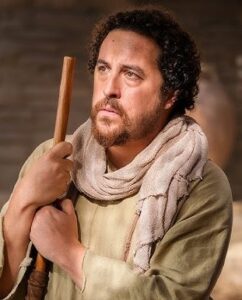 Feast: 3 May – with Saint Philip
Feast: 3 May – with Saint Philip
Patron of: of the dying, those who clean, shrink, and thicken cloth, hatters, and druggists.
Birth: 1st Century
Died: 62 AD, shortly after preaching the Gospel near the Temple in Jerusalem
Son of Alpheus (Alphaeus)
Brother of Jude (Thaddeus) the Apostle
Believed to be a cousin of Jesus
Usually considered author of Epistle bearing his name
Was the brother of Saint Jude and a cousin of Jesus. While serving as Jerusalem’s first bishop, he was arrested by the Jews and killed by being hurled down from the Temple roof. Symbol: fuller’s club, after being cast from the Temple roof Saint James was beaten to death with such a club.
(photo: The Chosen)
Saint Jude

Feast: 28 October – with Saint Simon
Patron of: Hope and impossible causes
Birth: 1st Century
Died: 65 AD, Kingdom of Armenia
(Thaddeus)
Brother of James the Apostle (the less)
Believed to be a cousin of Jesus
Usually considered author of Epistle bearing his name
A brother of Saint James the Less and a cousin of Jesus, wrote a Catholic Epistle of the New Testament. It is customary with many to pray to him in seemingly “hopeless” situations. Symbol: halberd, this long-handled and ax-like weapon was used by the Persian executioners of Saint Jude.
(photo: The Chosen)
Saint Simon
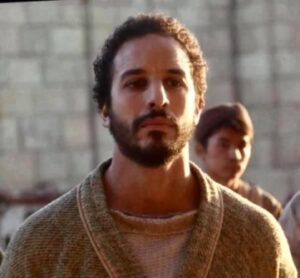
Feast: 28 October – with Saint Jude
Patron of: Saw workers and tanners
Birth: 1st Century Cana, Galilee, Judaea, Roman Empire
Died: 65 AD Province of Britain, Roman Empire
Called a Zealot (a person with very strong opinions)
The brother of James and Jude, who is surnamed the Zealot. He and Saint Jude are said to have preached in Egypt and Persia and to have suffered martrydom for the faith in Mesopotamia. Symbol: saw, usual symbol for Saint Simon, since, according to legend, he was martyred by being sawed into pieces.
(photo: The Chosen)
Saint James The Greater
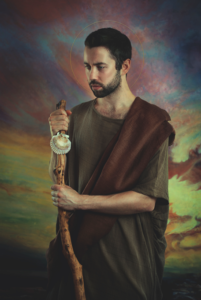
Feast: 25 July
Patron of: Pilgrims and knights
Birth: 5 BC, Bethsaida 1st Century
Died: 44 AD Jerusalem
Son of Zebedee
Elder brother of Apostle John
Son of Thunder” (Boanerges)
James is called James the Greater because another younger apostle was named James. (He should not be confused with this James, or the James who is a relative of Jesus, or the James who was an elder of the Church in Jerusalem and heard Peter’s defense of baptizing Gentiles.) James is the patron saint of hatmakers, rheumatoid sufferers, and laborers.
(photo: thesaintsproject.org_KristynBrown)
Saint Matthias
 Feast: is feast was originally celebrated on February 24 (or February 25 in leap years) but in 1969 was moved to May 14 so as to be celebrated outside of Lent
Feast: is feast was originally celebrated on February 24 (or February 25 in leap years) but in 1969 was moved to May 14 so as to be celebrated outside of Lent
Patron of: Carpenters, tailors, those with smallpox, and in prayers for perseverence and for hope
Birth: 1st century AD Judaea, Roman Empire
Died: 80 AD Jerusalem
Acts reveals that Matthias accompanied Jesus and the Apostles from the time of the baptism of Jesus to the Ascension and that, when it became time to replace Judas, the Apostles cast lots between Matthias and another candidate, St. Joseph Barsabbas. St. Jerome and the early Christian writers St. Clement of Alexandria and Eusebius of Caesarea attest that Matthias was among the 72 disciples paired off and dispatched by Jesus. Soon after his election, Matthias received the Holy Spirit with the other Apostles (Acts 2:1–4). He is not mentioned again in the New Testament.
Little is known with certainty of his life and martrydom. Symbol: lance, it is an old tradition that Saint Matthias was martyred in southern Asia with such a weapon.
Who Are the Twelve Apostles, and What Happened to Them?
The twelve apostles are Peter, Andrew, James (son of Zebedee), John, Philip, Bartholomew, Thomas, Matthew, James (son of Alphaeus), Thaddeus, Simon (the Zealot), and Judas.
Judas took his own life (Matt. 27:1-5), and St. John, the son of Zebedee, was assigned by Jesus to take of his mother Mary (John 19:25-27), and a strong tradition holds that he later died of natural causes at an old age in Ephesus.
Scripture conveys that James (the Greater), the son of Zebedee, was martyred by King Herod Agrippa I (Acts 12:1-3), although the king himself was struck dead by an angel not long afterward (Acts 12:19-23). There is abundant testimony in the early Church that St. Peter, who was imprisoned on the occasion of James’s execution (Acts 12:3), was martyred around twenty years later in Rome, along with St. Paul.
St. James (the Lesser), son of Alphaeus, is often identified with St. James, “the brother,” i.e., relative, of Jesus, the bishop of Jerusalem noted in Acts 15, was who martyred by stoning in Jerusalem in the A.D. 60s, as Eusebius testifies (Church II, 23), and also Josephus, the noted Jewish historian of antiquity. As Pope Emeritus Benedict XVI has stated, “Among experts, the question of the identity of these two figures with the same name, James son of Alphaeus and James ‘the brother of the Lord,’ is disputed.”
We also see that tradition holds that St. Thomas preached in India and suffered martyrdom there, as Pope St. John Paul II affirmed in his 1986 apostolic visit. In addition, tradition holds that St. Andrew was martyred via a form of crucifixion around A.D.60.
St. Bartholomew—also understood by many scholars as “Nathaniel”—is also believed to have been martyred, reportedly either by beheading or being flayed alive.
St. Philip may have been martyred in Hierapolis (located within modern-day Turkey), although that may be the tomb of St. Philip the deacon, noted in the Acts of the Apostles.
St. Matthew, The Roman Martyrology conveys, was martyred, although the manner of his death is disputed.
Finally, tradition also holds that St. Simon (the Zealot), the son of Clopas and who is also called Jude, was martyred, as was his apostolic companion, St. Jude (Thaddeus). They are both listed in the Roman Martyrology and the Roman canon (Eucharistic Prayer I).
